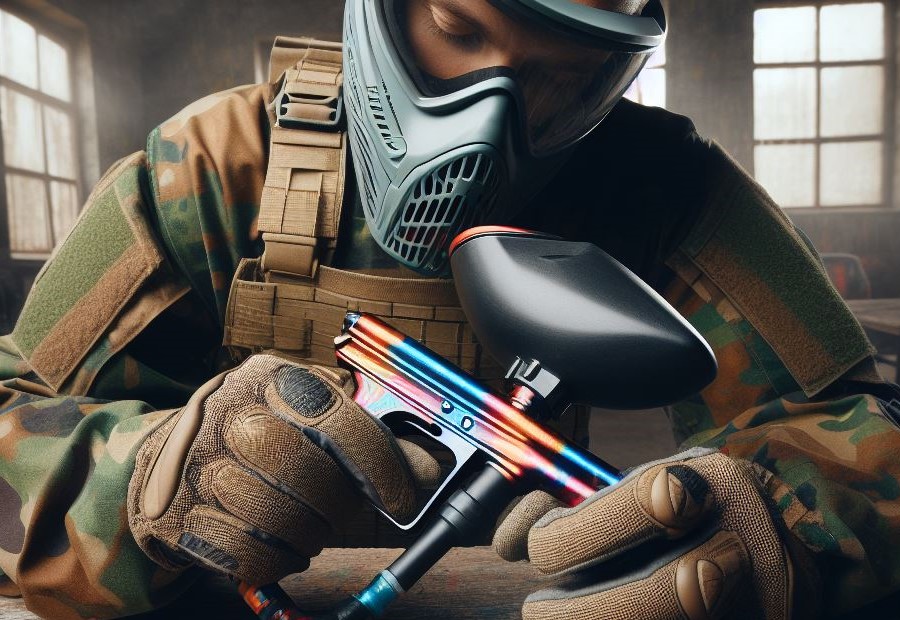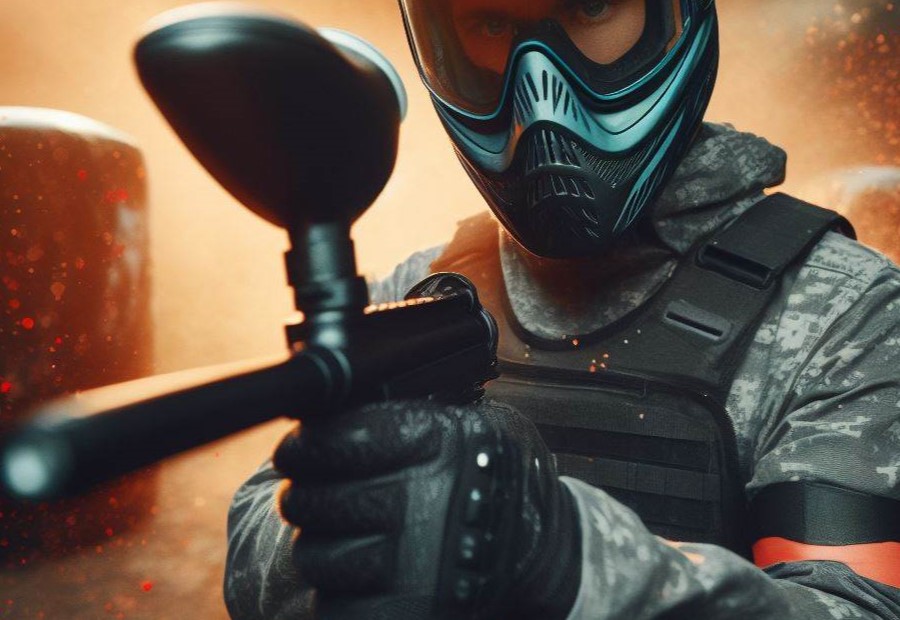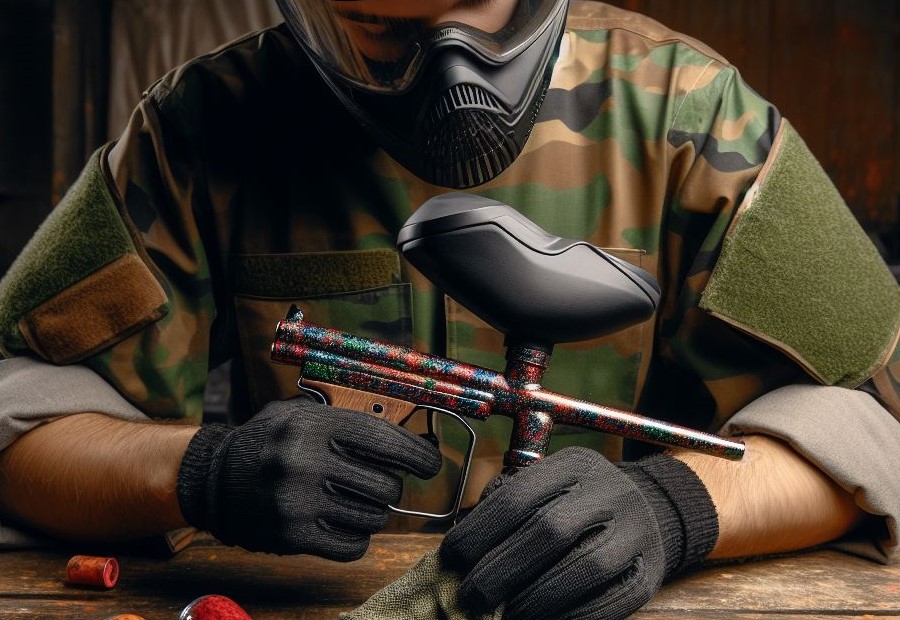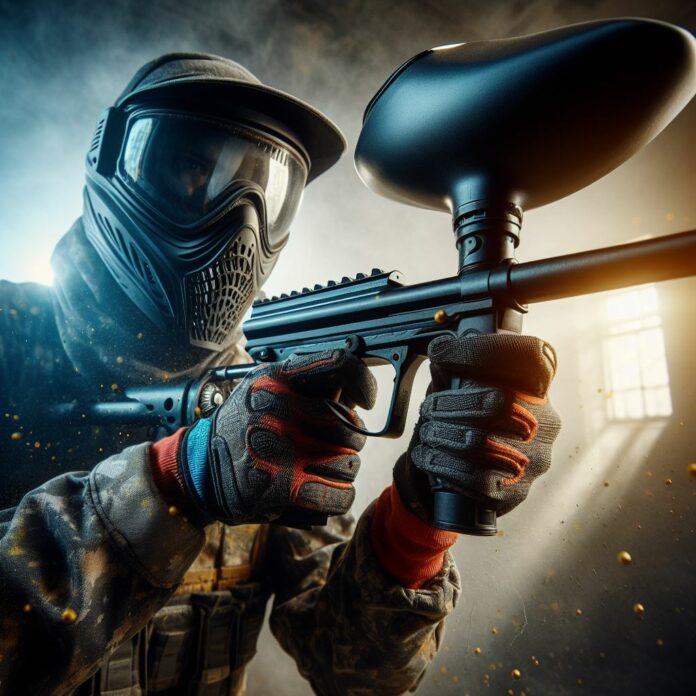Regular servicing is essential for maintaining the performance and longevity of your paintball gun. Whether you’re a recreational player or a competitive athlete, taking care of your equipment is crucial to ensure optimal function and reliability on the field.
The frequency of servicing your paintball gun can vary depending on several factors. These factors include the frequency of use, environmental conditions, and the type of paintballs used.
Understanding these factors will help you determine the appropriate schedule for servicing your paintball gun.
To service a paintball gun, there are general guidelines to follow. These include inspection and cleaning, lubrication, O-ring replacement, and tank and air system maintenance. These steps help prevent issues such as malfunctioning, leaks, and poor accuracy.
Now, the question arises: How often should you service a paintball gun? The answer depends on your usage patterns. If you use your paintball gun regularly, weekly or bi-weekly servicing is recommended.
For those who play occasionally, monthly servicing should be sufficient. And if you use your paintball gun infrequently, seasonal servicing should be adequate.
It’s important to pay attention to signs that indicate your paintball gun needs immediate servicing. These signs include inconsistent velocity, air leaks, choppy paintballs, or any other abnormal behavior.
If you notice any of these signs, it’s crucial to address them promptly to prevent further damage and ensure your paintball gun performs at its best.
By following a regular service schedule and promptly addressing any issues, you can keep your paintball gun in top condition and enjoy a seamless and enjoyable paintball experience.
Why is Regular Service Important for Paintball Guns?

Regular service is paramount for paintball guns to guarantee their optimal performance and longevity. Neglecting regular maintenance can result in problems such as diminished accuracy, inconsistent velocity, and potential malfunctions.
To avert these issues, it is imperative to regularly clean and lubricate the gun. Cleaning the paintball gun effectively eliminates dirt, debris, and paint residue that can obstruct the internal components.
By maintaining cleanliness, it facilitates smoother operation and hinders blockages that could hinder the firing mechanism.
Lubrication plays a crucial role in reducing friction between moving parts, ensuring seamless and dependable action. This prevents wear and tear on the gun’s internal components and helps preserve its efficiency.
Furthermore, regular service enables timely detection and resolution of any minor issues before they escalate into major problems.
This encompasses inspecting for leaks, loose screws, and damaged seals. Giving prompt attention to these maintenance needs can prevent costly repairs or the necessity to replace the entire gun.
Factors Affecting the Frequency of Paintball Gun Servicing

Frequency of Use
The frequency of use is a crucial factor to take into account when it comes to maintaining a paintball gun.
For those individuals who frequently use their paintball guns, it is recommended to service them on a weekly or bi-weekly basis. This ensures that any potential issues or wear and tear are promptly addressed to maintain optimal performance.
For those individuals who occasionally use their paintball guns, a monthly servicing is sufficient. This helps to prevent any potential problems that may arise from the gun being unused for extended periods of time.
For those individuals who infrequently use their paintball guns, such as during specific seasons or events, a seasonal servicing is recommended. This assures that the gun is in proper working condition when it is needed again.
By adhering to the suggested servicing frequencies based on the frequency of use, you can extend the lifespan of your paintball gun and ensure its reliable performance during gameplay.
Environmental Conditions
When it comes to the maintenance and longevity of paintball guns, environmental conditions play a crucial role. Here are some factors to consider:
- Temperature: Extreme temperatures can have a significant impact on the performance of paintball guns. Cold temperatures can cause the gun’s parts to contract and potentially freeze, resulting in reduced efficiency and potential damage. Conversely, excessive heat can cause the gun to overheat and malfunction.
- Humidity: High humidity levels can lead to moisture buildup inside the gun, which can cause corrosion and rusting of metal components. It is important to keep the gun dry and store it in a cool, dry place.
- Dust and debris: Paintball guns are susceptible to dust and debris, which can accumulate in various components and affect their functionality. Regular cleaning and maintenance can help prevent clogs and ensure smooth operation.
- Water exposure: While paintball guns are designed to be water-resistant to a certain extent, exposure to water can still cause damage. It is important to avoid submerging the gun in water and keep it protected during rainy or wet conditions.
- Impact and rough handling: Environmental conditions also include how the gun is handled during gameplay. Rough handling or accidental impacts can result in damage to the gun’s internal mechanisms or external components.
By considering and taking appropriate measures to protect the paintball gun from these environmental conditions, you can ensure optimal performance and longevity.
Type of Paintballs Used
| Type of Paintballs Used | Characteristics |
| Standard Paintballs | These are the most common type of paintballs used in paintball games. They have a standard size of 0.68 caliber and are filled with a water-based paint. They are suitable for most paintball guns and offer a balanced combination of accuracy, consistency, and affordability. |
| Recreational Paintballs | Recreational paintballs are designed for casual players and beginners. They are often larger in size, ranging from 0.68 to 0.71 caliber, and have thicker shells. These paintballs are more forgiving and less likely to break upon impact. They offer a slower speed and reduced accuracy, but are ideal for recreational gameplay. |
| Tournament-Grade Paintballs | Tournament-grade paintballs are specifically designed for competitive play. They are smaller in size, typically 0.68 caliber, and have a thinner shell. These paintballs are more brittle and break easily upon impact, ensuring clear and accurate hits. They are also more consistent in terms of shape and weight, which is crucial for professional players. |
| Low-Impact Paintballs | Low-impact paintballs are designed for younger players or those who prefer a less intense paintball experience. They have a smaller size, around 0.50 caliber, and a softer shell. These paintballs offer lower velocity and reduced impact, minimizing the risk of bruises or welts. They are ideal for recreational players or family-friendly events. |
General Guidelines for Paintball Gun Servicing

Inspection and Cleaning
Regular inspection and cleaning are essential for ensuring the proper functioning and longevity of a paintball gun. By inspecting the gun on a regular basis, you can easily identify any signs of damage, wear, or malfunctioning parts.
Additionally, cleaning the gun thoroughly helps in the removal of dirt, debris, and paint residue that can adversely affect its overall performance.
To begin the cleaning process, it is important to disassemble the gun following the manufacturer’s instructions. Take time to carefully inspect each component for any signs of damage, such as cracks or excessive wear.
Use a soft cloth or brush to effectively remove any dirt or debris from both the exterior and interior parts of the gun. Pay particular attention to the barrel, breech, and feed system, as these areas are prone to buildup.
The barrel should be cleaned using a squeegee or barrel swab to eliminate any paint residue or obstructions. It is also crucial to inspect and clean the O-rings, ensuring they are in good condition and adequately lubricated.
Non-metal parts, including the grip, should be cleaned using a mild soap and water solution. Before reassembling the gun, ensure that all the components are thoroughly dried.
Once dry, apply a thin layer of lubricant to the moving parts, paying special attention to areas with friction or metal-to-metal contact. This will help ensure smooth operation and prevent any potential issues.
By incorporating a regular inspection and cleaning routine for your paintball gun, you can effectively prevent potential issues, maintain optimal performance, and significantly extend its overall lifespan.
Lubrication
Lubrication is an essential step in maintaining the performance and longevity of your paintball gun. Proper lubrication helps reduce friction between moving parts, preventing wear and tear.
When lubricating your paintball gun, it is important to use a high-quality paintball-specific lubricant. Regularly lubricating your paintball gun will ensure smooth operation and prevent malfunctions during gameplay.
To properly lubricate your paintball gun, begin by applying a small amount of lubricant to the o-rings and any moving parts that come into contact with each other. Use a soft cloth or your finger to evenly distribute the lubricant.
It is vital to avoid using excessive amounts of lubricant as this can attract dirt and debris, which may lead to potential problems.
It is recommended to lubricate your paintball gun after every few uses or whenever you notice any signs of decreased performance or increased friction. Regular lubrication will help maintain the efficiency and reliability of your paintball gun.
O-Ring Replacement
When it comes to paintball gun servicing, one crucial step to consider is the replacement of o-rings. O-rings, which are small rubber seals, play a vital role in maintaining air pressure and preventing leaks in the paintball gun.
- Inspect the o-rings for any signs of wear, cracks, or damage.
- Remove the old o-rings using a small pick or o-ring removal tool.
- Clean the grooves and surfaces where the o-rings will be placed, ensuring they are free from debris.
- Apply a small amount of paintball gun oil or lubricant to the new o-rings to enhance their performance.
- Place the new o-rings in the appropriate grooves, making sure they fit snugly.
- Gently push the o-rings into place, being careful not to stretch or damage them.
- Once all the o-rings are replaced, perform a leak test to ensure they are properly sealed.
- Reassemble the paintball gun and test its functionality before using it in a game.
A well-maintained o-ring can significantly improve the performance and reliability of your paintball gun. By regularly inspecting and replacing o-rings, you can avoid air leaks and ensure smooth operation during gameplay.
Tank and Air System Maintenance
Tank and Air System Maintenance is crucial for keeping your paintball gun in optimal condition. In order to ensure proper functionality and performance, follow these steps:
- Clean the tank and air system components regularly using a soft cloth or brush to remove any dirt or debris.
- Inspect the tank and air system for any signs of damage, such as leaks or cracks. If any issues are found, they should be addressed immediately.
- Check the tank’s pressure gauge to ensure it is within the recommended range. Adjust the pressure if necessary, according to the manufacturer’s guidelines.
- Inspect the O-rings on the tank and air system for any signs of wear or damage. Replace any worn or damaged O-rings to prevent air leaks.
- Apply a small amount of lubricant to the tank’s regulator and other moving parts of the air system to ensure smooth operation.
- Test the air system to ensure it is providing consistent air pressure. Make any adjustments or repairs as needed.
Regular Tank and Air System Maintenance will help prolong the lifespan of your paintball gun and ensure its reliable performance during gameplay.
How Often Should You Service a Paintball Gun?

Regular Use – Weekly or Bi-Weekly Servicing
Regular use of a paintball gun requires weekly or bi-weekly servicing to ensure its smooth operation and longevity.
- Inspection and Cleaning: It is important to regularly inspect the paintball gun for any dirt, debris, or paint residue. Make sure to clean the barrel, breech, and other components using a soft cloth and mild cleaning solution.
- Lubrication: To prevent friction and ensure smooth movement, apply lubricant to the O-rings, moving parts, and air system. It is recommended to use a paintball-specific lubricant recommended by the manufacturer.
- O-Ring Replacement: Check the O-rings for any signs of wear, cracks, or leaks. If necessary, replace them to maintain proper sealing and prevent air leaks.
- Tank and Air System Maintenance: Inspect the paintball tank and air system regularly for any damage or leaks. Make sure to ensure proper CO2 or compressed air pressure. Additionally, remember to clean and lubricate the tank threads regularly.
If you use your paintball gun frequently, it is crucial to service it on a weekly or bi-weekly basis. This regular maintenance routine will prevent malfunctions, improve performance, and extend the lifespan of your paintball gun.
Neglecting regular servicing can result in decreased accuracy, inconsistent firing, and potential damage to the internal components.
Occasional Use – Monthly Servicing
When it comes to occasional use of paintball guns, monthly servicing is highly recommended to ensure optimal performance and longevity. Here are some important aspects to consider:
- Inspection and Cleaning: It is essential to regularly inspect and clean the paintball gun to remove dirt, debris, and paint residue that can potentially affect its functionality and accuracy. Pay special attention to the barrel and firing mechanism.
- Lubrication: Another crucial aspect is to apply lubricant to the necessary parts of the paintball gun. This helps reduce friction and ensures smooth operation. It is important to follow the manufacturer’s guidelines for the appropriate type and amount of lubricant to use.
- O-Ring Replacement: Make sure to check the O-rings regularly and promptly replace any damaged or worn-out ones. O-rings play a vital role in proper sealing and preventing air leaks, so keeping them in good condition is essential.
- Tank and Air System Maintenance: Regularly inspect the tank and air system components, such as regulators and hoses, for any signs of wear or damage. It is important to ensure proper pressurization and functioning to avoid malfunctions during use.
By adhering to these monthly servicing tasks, you can significantly enhance the performance and reliability of your paintball gun, even with occasional use.
However, it’s important to note that the frequency of servicing may vary depending on individual factors.
Therefore, use your judgment and consider seeking professional servicing if necessary. Remember, proper maintenance is key to enjoying a seamless paintball experience.
Infrequent Use – Seasonal Servicing
It is recommended to service your paintball gun on a seasonal basis, especially for infrequent use. Here are the steps you can follow for seasonal servicing:
- Inspect the paintball gun for any visible damage or wear.
- Clean the exterior of the gun using a soft cloth and mild detergent.
- Disassemble the gun and clean each component thoroughly using a paintball-specific cleaning solution.
- Inspect and clean the barrel to remove any debris or paint residue.
- Lubricate the moving parts of the gun with a paintball-safe lubricant.
- Replace any worn or damaged O-rings with new ones.
- Check and maintain the tank and air system, ensuring proper pressure and functionality.
- Reassemble the gun and perform a test fire to ensure everything is working correctly.
Pro-tip: When storing your paintball gun during periods of infrequent use, make sure to remove the air tank to prevent any pressure buildup or potential damage to the gun.
Signs Your Paintball Gun Needs Immediate Servicing
Here are some signs that indicate your paintball gun needs immediate servicing:
- Leaking air or gas: If you notice any leaks coming from your gun, it is a clear sign that there is an issue with the seals or O-rings. This should be addressed promptly to ensure proper functioning.
- Inconsistent velocity: If your shots are not consistently reaching the same velocity, it could indicate a problem with the regulator or other internal components. This can affect the accuracy and performance of your gun.
- Paint breaking in the barrel: If paintballs are consistently breaking in the barrel instead of upon impact, it may be a result of barrel damage or improper bore sizing. This can lead to barrel blockages and affect your shots.
- Trigger sticking or not resetting: If your trigger is sticking or not resetting properly after each shot, it can impact your ability to fire rapidly and accurately. This could be due to dirt, debris, or worn-out trigger components.
- Unusual sounds or vibrations: Any abnormal sounds or vibrations coming from your gun during operation can indicate loose parts, worn-out internals, or other mechanical issues. These should be investigated and resolved promptly.
Remember, regular maintenance and cleaning can help prevent these issues from occurring. If you notice any of these signs, it is important to seek immediate servicing to keep your paintball gun in optimal condition.
Frequently Asked Questions
How often should I clean my paintball gun?
According to Paintball USA, it is important to clean your paintball gun after each game to maintain its performance. Dirty guns can result in poor accuracy and potential jams.
What cleaning methods should I use for my paintball gun?
Paintball USA recommends using warm water and dish detergent to wash your gun, along with a small brush or toothbrush to remove caked-on paintballs. Additionally, lubricating the front and rear bolt o-rings with paintball gun oil is essential.
Should I fully disassemble my paintball gun for cleaning?
The person in the Reddit post mentioned using a microfiber cloth to clean their gun but did not fully disassemble it.
While it’s not necessary to disassemble the gun every time, it is advisable to at least clean the barrel with a squeegee and soft brush to remove paint residue and dirt for better shooting accuracy.
How often should I service my paintball gun?
Paintball USA recommends cleaning and maintaining your paintball gun after every 3 or 4 times you use it. However, it is best to clean it thoroughly after each game to ensure optimal performance.
What precautions should I take for safe storage of my paintball gun?
To ensure safe storage, it is important to remove the HPA or CO2 tank from the gun and store it in a cool, dry place without the tank attached. Additionally, keeping a barrel plug on the gun and the safety button engaged when not on the playing field is crucial.
Can I reuse paintballs that have fallen on wet ground?
No, using paintballs that have fallen on wet ground and have swelled can cause jams in your gun. It is best to discard them and use fresh, undamaged paintballs for optimal performance.

